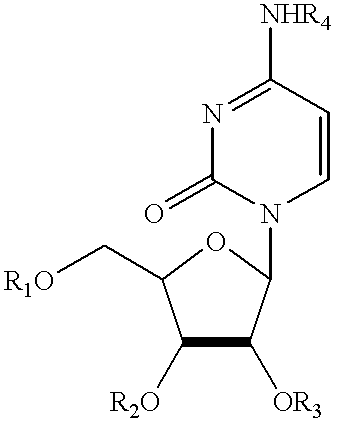Pyrimidine nucleotide precursors for treatment of systemic inflammation and inflammatory hepatitis
a technology of pyrimidine and nucleotide precursors, which is applied in the field of therapeutic and prophylaxis agents, can solve the problems of not directly addressing the improvement of tissue resistance to inflammatory stimuli, endotoxins, or inflammatory mediators, and the inability to use antibodies as prophylaxis in susceptible patients, and is expensive or impractical
- Summary
- Abstract
- Description
- Claims
- Application Information
AI Technical Summary
Benefits of technology
Problems solved by technology
Method used
Image
Examples
example 1
Triacetyluridine and Uridine Improve Survival in Mice Treated with Killed E. coli
Purpose
Sepsis syndrome can be initiated by gram-negative bacteria even if they are not alive, since the primary trigger is endotoxin, a component of the bacterial cell wall. The purpose of this study was to determine the effect of oral triacetyluridine and parenteral uridine on survival of mice treated with a lethal dose of killed E. coli bacteria
Methods
Eighteen female Balb / C mice (eight weeks old) were divided into groups of six animals each. All mice received 500 micrograms of an acetone powder of E. coli (serotype 0111:B4) suspended by sonication in 0.2 ml of saline. Mice in one group received uridine (2000 mg / kg in 0.2 ml saline) by i.p. injection two hours prior to administration of the E. coli. Another group of mice received triacetyluridine (6000 mg / kg in a vehicle of 1:1 corn oil / water containing 2.5% Tween 80) by oral intubation. Survival was monitored for one week.
A. n=6 E. coli (Control)
B. n=...
example 2
Dose-response Study of Uridine in Protection of Tissues from Endotoxin Damage
Purpose
The purpose of this study was to determine the dose-response characteristics for uridine in prevention of inflammatory tissue damage caused by endotoxin (LPS).
Methods
Female Balb / C mice (eight weeks old) were divided into six groups of six animals each. One group of animals remained untreated to provide basal values for serum chemistry indices of tissue damage. Mice in the remaining five groups received 100 micrograms of Salmonella typhimurium endotoxin by i.p. injection in a volume 0.2 ml saline. Two hours prior to endotoxin administration, the five groups of mice received uridine in doses of 0, 500, 1000, 2000 and 4000 mg / kg i.p. (in 0.2 ml saline) respectively. Eighteen hours after endotoxin administration, blood samples were collected for determination of serum chemistry values of indicators of tissue damage.
Results
Uridine produced a dose-dependent protection of tissues against damage from endotox...
example 3
Oral Triacetyluridine Improves Survival of Mice Treated with a Lethal Dose of Salmonella typhimurium Endotoxin
Purpose
Sepsis syndrome caused by gram-negative bacteria is mediated primarily through endotoxin, a lipopolysaccharide constituent of the bacterial wall. The purpose of this experiment was to determine the effect of an orally-administered uridine prodrug (Triacetyluridine; TAU) on survival of mice treated with a lethal dose of purified Salmonella typhimurium endotoxin (LPS).
Methods
Twenty female Balb / C mice (eight weeks old) were divided into two groups of ten animals each. All mice received 100 micrograms of Salmonella typhimurium endotoxin by intraperitoneal injection in 0.2 ml of saline. One group of mice received triacetyluridine (6000 mg / kg in a vehicle of 1:1 corn oil / water containing 2.5% Tween 80) by oral intubation. Survival was monitored for one week.
Results
All ten of the animals which received endotoxin alone died within 48 hours. Nine of the ten mice that received ...
PUM
| Property | Measurement | Unit |
|---|---|---|
| molecular weight | aaaaa | aaaaa |
| volume | aaaaa | aaaaa |
| volume | aaaaa | aaaaa |
Abstract
Description
Claims
Application Information
 Login to View More
Login to View More - R&D
- Intellectual Property
- Life Sciences
- Materials
- Tech Scout
- Unparalleled Data Quality
- Higher Quality Content
- 60% Fewer Hallucinations
Browse by: Latest US Patents, China's latest patents, Technical Efficacy Thesaurus, Application Domain, Technology Topic, Popular Technical Reports.
© 2025 PatSnap. All rights reserved.Legal|Privacy policy|Modern Slavery Act Transparency Statement|Sitemap|About US| Contact US: help@patsnap.com



